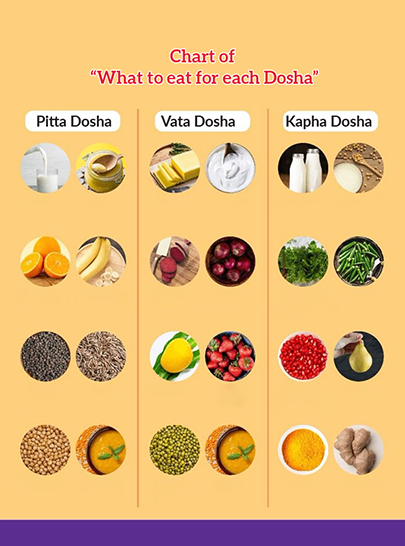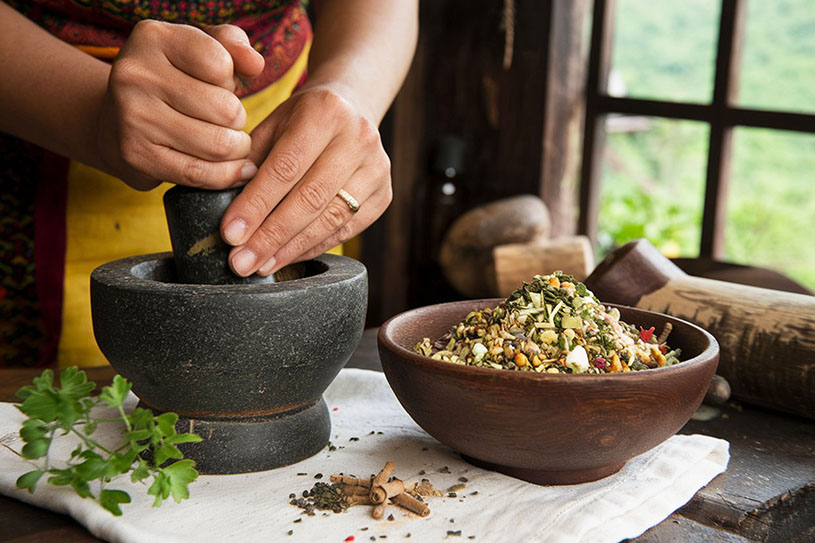Food as Medicine: The Ayurvedic Way to Nourish, Heal, and Thrive
By Dr. Anjali Agarwal

“When the diet is wrong, medicine is of no use. When diet is correct, medicine is of no use.” – Charaka Samhita
In the ancient science of Ayurveda, food is not just nourishment—it is medicine. Every bite we take, every sip we drink, and every fast we undertake has the power to either sustain our health or disturb our balance. Unlike modern dietary systems that often rely on one-size-fits-all prescriptions, Ayurveda offers a personalized approach, emphasizing the interplay between individual constitution (Prakriti), digestive strength (Agni), seasonal changes (Ritu), and the energetics of food (Virya).
This holistic system does not separate physical health from mental clarity or spiritual well-being. At its core, Ayurveda teaches that diet and fasting are not merely practices—they are sacred disciplines for aligning body, mind, and soul.

The Ayurvedic View of Diet (Ahara)
In Ayurveda, Ahara (diet) is one of the three pillars of life, alongside Nidra (sleep) and Brahmacharya (right use of energy). A balanced diet nourishes Dhatus (body tissues), strengthens Ojas (vital essence), and promotes mental and emotional well-being.
Key Principles of Ayurvedic Diet:
1.Eat According to Your Dosha:
-
- Vata individuals (air + ether) benefit from warm, moist, and grounding foods like stews, ghee, and root vegetables.
- Pitta types (fire + water) require cooling, mildly spiced meals with plenty of leafy greens, coconut, and grains like rice.
- Kapha types (earth + water) thrive on light, dry, and stimulating foods like beans, spices, and bitter greens.
2.Eat Seasonal and Fresh Foods: Ayurveda insists on eating fresh, local, and seasonal foods that are easy to digest and harmonize with the body’s current state.
3. Enhance Agni (Digestive Fire): The strength of your Agni determines how well you digest, absorb, and assimilate food. Weak Agni leads to Ama (toxins), while strong Agni promotes vitality.
4. Food Combinations Matter: Certain food combinations, such as milk with fish or fruit with dairy, are considered incompatible and create toxins.
5. Mindful Eating: Eat in a calm, seated position. Avoid distractions, chew foods thoroughly, and honor them with gratitude. Such an approach turns eating into a sacred ritual.

Fasting in Ayurveda (Upavasa)
Unlike many modern fasting trends, Ayurvedic fasting is gentle, purposeful, and tailored to the individual. Known as Upavasa (literally “staying close to the Divine”), fasting is not deprivation but a way to rest the digestive system, cleanse the body, and refine the mind.
Types of Ayurvedic Fasting:
- Light Fasting (Langhana): Skipping a meal, having only soups or warm water for a day to balance excess Kapha or Ama.
- Mono-diet Fasting: Eating only one type of food—commonly Kitchari (a nourishing blend of rice and mung dal with ghee and spices)—to gently detox and balance all three doshas.
- Juice or Fruit Fasting: Beneficial in hot weather or for individuals with strong Pitta, using cooling juices like pomegranate or coconut water.
- Dry Fasting (Nirjala Upavasa): Reserved for those with strong constitutions and often practiced for spiritual purposes on days like Ekadashi (11th lunar day).
Benefits of Ayurvedic Fasting:
- The Kindle’s digestive fire
- Eliminates accumulated toxins (Ama)
- Promotes mental clarity
- Enhances spiritual practices like meditation
- Reboots the metabolism gently without shocking the system
Importantly, Ayurveda does not advocate prolonged or extreme fasting, especially for Vata individuals or those who are elderly, pregnant, or ill.
Intermittent Fasting: An Ancient Practice with Modern Validation
Although “Intermittent Fasting” (IF) has gained modern popularity in the West, its roots lie deep in Ayurvedic and Yogic traditions. In Ayurveda, intermittent fasting is not a trend—it’s a lifestyle of alignment.
The idea of leaving adequate space between meals (typically 4–6 hours), not eating after sunset, and allowing 12–16 hours overnight for digestion and restoration was a natural part of ancient Indian living.
Ayurveda and Circadian Rhythms:
Ayurveda beautifully aligns with what modern science now calls chrononutrition. The Ayurvedic clock suggests:
- Morning (6–10 AM): Kapha time, best for a light breakfast
- Midday (10 AM–2 PM): Pitta time, strongest digestion—ideal time for your largest meal
- Evening (6–10 PM): Kapha again—light dinner, if any, is recommended before 7 PM.
This approach supports intermittent fasting by encouraging an early dinner and long overnight fasting window, which enhances digestion, hormonal balance, and mental clarity.
Food as Medicine: The Pharmacy in Your Kitchen

Ayurveda does not separate food from medicine. Each herb, spice, grain, vegetable, and fruit is a potential remedy when matched correctly with an individual’s constitution and imbalance.
Examples of Common Ayurvedic Healing Foods:
- Ginger: Kindles Agni, reduces Kapha, aids digestion.
- Turmeric: Anti-inflammatory, enhances immunity, purifies blood
- Ghee: Nourishes tissues, carries herbs deep into cells, and calms Vata
- Mung Dal: Detoxifying, light, and easy to digest
- Triphala: A combination of three fruits for gentle daily detoxification
Ayurveda considers six tastes (Shad Rasa) in every meal—Sweet, Sour, Salty, Bitter, Pungent, and Astringent—to ensure holistic nourishment and doshic balance.
Rituals and Respect for Food
Ayurveda teaches that food should be prepared with love, eaten with gratitude, and digested with rest. The state of the cook, the intention behind the meal, and even the way food is served affect its subtle energy, or Prana.
Simple Ayurvedic Food Rituals:
- Start meals with a prayer or moment of silence
- Eat seated and without multitasking
- Avoid cold drinks, which extinguish digestive fire
- Rest for a few minutes after meals, then take a gentle walk (Shatapavali)
- Avoid reheated or microwaved food—fresh is best
A Return to Sacred Simplicity
In an age of fad diets, superfoods, and weight-loss trends, Ayurveda offers a timeless reminder: eat simply, eat mindfully, and eat according to your nature. Fasting, too, must be done with awareness, humility, and harmony—not as punishment, but as purification.
By honoring food as sacred, fasting as spiritual, and eating as healing, we align with nature’s wisdom and unlock the body’s innate intelligence.
In the words of the Bhagavad Gita (6.16–6.17):
“Yoga is not for one who eats too much or for one who fasts too much… but for one who is moderate in food, recreation, and effort in work.”

Ayurveda invites us to rediscover this middle path—not just for the body, but for the soul.
Glossary of Terms from Ayurveda and Indian Tradition
Ahara Food or diet
Explanation: One of the three pillars of life in Ayurveda encompasses not only what we eat, but also how, when, and why we consume it.
Agni Digestive fire
Explanation: The vital energy responsible for digestion and metabolism. Balanced Agni leads to optimal health; weak Agni causes toxins.
Ama Toxins
Explanation: Undigested or improperly digested food that turns into sticky waste, clogging bodily channels and causing disease.
Prakriti Natural constitution
Explanation: One’s unique body-mind type is determined by the balance of the three doshas at birth.
Dosha Energetic body-mind principles
Explanation: The three doshas—Vata (air & ether), Pitta (fire & water), and Kapha (earth & water)—govern physical and mental functions. Balanced doshas = health.
Vata Dosha made of air and ether
Explanation: Controls movement, the nervous system, and communication in the body. Qualities: cold, light, dry.
Pitta Dosha made of fire and water
Explanation: Governs digestion, metabolism, and heat. Qualities: hot, sharp, oily.
Kapha Dosha made of earth and water
Explanation: Maintains structure, lubrication, and stability. Qualities: heavy, slow, steady.
Langhana Lightening or fasting therapy
Explanation: An Ayurvedic technique that reduces excess toxins, or Kapha, through light diets or short fasts.
Upavasa Fasting
Explanation: Literally means “staying close to the Divine.” This practice is often carried out on spiritual days to cleanse the body and mind.
Kitchari Traditional Indian dish
Explanation: A simple, nourishing porridge made from rice and mung dal. This dish is commonly consumed during periods of fasting and detoxification.
Virya the potency or energy of food.
Explanation: Describes the heating or cooling effect of food on the body and mind.
Ojas Vital essence
Explanation: The subtle energy that results from good digestion and balanced living. It sustains immunity, vitality, and happiness.
Ritu
Meaning: Season
Explanation: Ayurveda prescribes different diets and routines for each season to maintain doshic balance.
Shad Rasa
Meaning: Six tastes
Explanation: Sweet, sour, salty, bitter, pungent, and astringent. All six should be present in a balanced meal for complete nourishment.
Triphala Three fruits
Explanation: A classical Ayurvedic formula made from amalaki, haritaki, and bibhitaki. This formula is commonly used for detoxification and digestion purposes.
Prana Life force
Explanation: The vital breath or energy that sustains life. It can be found in fresh food, clean air, and sacred environments.
Ekadashi Eleventh day of the lunar cycle
Explanation: A spiritually powerful day observed with fasting and prayer in many Hindu traditions.
Shatapavali Hundred steps
Explanation: The traditional Ayurvedic practice of walking 100 steps after meals to aid digestion.
Brahmacharya The right use of energy or celibacy.
Explanation: One of the three pillars of Ayurveda refers to moderation and conscious channeling of life energy, not just abstinence.
Charaka Samhita An ancient Ayurvedic text
The sage Charaka penned one of the foundational treatises of Ayurveda, emphasizing food, health, and ethics.
About the Author:
Dr. Anjali Agarwal is a renowned Indian-American cardiologist and esteemed professor at a prestigious university in the United States. With a passion for blending modern medical science with ancient Indian wisdom, Dr. Agarwal has made significant contributions to the field of cardiology and holistic health. Her groundbreaking research has focused on the integration of Ayurveda and traditional Indian medicine with contemporary cardiology practices. Dr. Agarwal’s work has garnered international recognition for its innovative approach to cardiovascular health, emphasizing holistic wellness, nutrition, and mindfulness. She is not only a pioneer in her field but also a dedicated educator, shaping the future of medicine and inspiring the next generation of healthcare professionals.

























